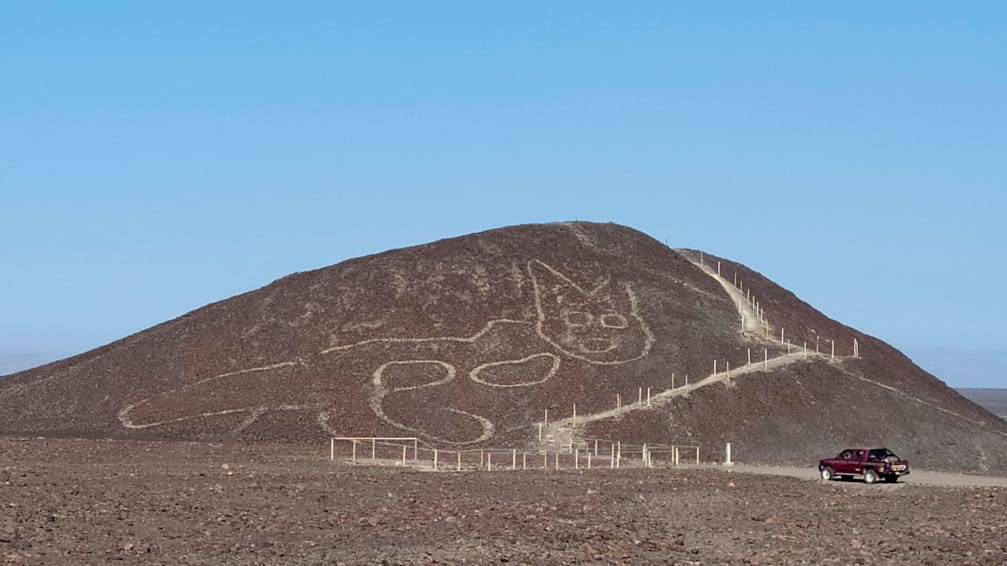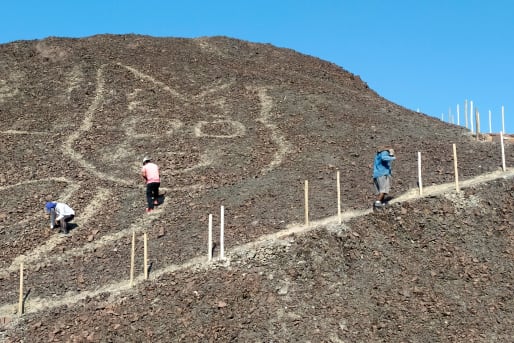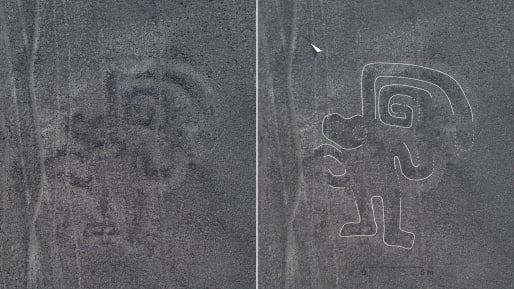 Nazca Lines: Archaeologists discover 2,000-year-old cat figure in Perú. Credit: Jhony Islas/AP
Nazca Lines: Archaeologists discover 2,000-year-old cat figure in Perú. Credit: Jhony Islas/AP–
A huge feline figure carved into an arid hillside over 2,000 years ago has been discovered in southern Perú, according to the country’s Ministry of Culture.
–
–
The ancient geoglyph, which measures 37 meters (121 feet) across, forms part of the Nazca Lines, a collection of hundreds of mysterious artworks etched onto a plateau 250 miles south of Lima.
–
–
The cat joins an array of other zoomorphic drawings found across the region’s landscape over the last century, including depictions of a hummingbird, a monkey and a pelican. The discovery was made during maintenance work at a visitor vantage point in what is already a popular tourist destination.
–
–

The feline figure was found on a hillside in Perú’s Pampas de Jumana region. Credit: Jhony Islas/AP
–
–
“The figure was barely visible and was about to disappear as a result of its location on a fairly steep slope and the effects of natural erosion,” read a ministry press release.
–
–
After undertaking cleaning and conservation work, archaeologists uncovered a series of lines varying in width from 30 to 40 centimeters (12 to 16 inches). The style of the artwork suggests that it was created between 200 B.C. to 100 B.C., in the late Paracas period, the ministry said.
–
“Representations of this type of feline are frequently found in the iconography of ceramics and textiles in the Paracas society,” the press release explained.
Source of intrigue
The Nazca Lines were created by people from pre-Hispanic societies who removed the top layers of rock and gravel to reveal a lighter-colored bedrock beneath. Although very few human-like figures have been found in the region, archaeologists have discovered large-scale depictions of animals, birds, plants and everyday objects.
–
–
A number of mysterious geometric shapes and patterns — including spirals and triangles — were also carved into the desert landscape.
The lines and geoglyphs cover an area of around 450 square kilometers (174 square miles) and were created between 500 B.C. and 500 A.D., according to UNESCO, which added the site to its World Heritage List in 1994, describing it as one of “archaeology’s greatest enigmas.”
–
–
–
–
–
“They are the most outstanding group of geoglyphs anywhere in the world and are unmatched in its extent, magnitude, quantity, size, diversity and ancient tradition to any similar work in the world,” reads a listing on UNSECO’s website. “The concentration and juxtaposition of the lines, as well as their cultural continuity, demonstrate that this was an important and long-lasting activity, lasting approximately one thousand years.”
“They are the most outstanding group of geoglyphs anywhere in the world and are unmatched in its extent, magnitude, quantity, size, diversity and ancient tradition to any similar work in the world,” reads a listing on UNSECO’s website. “The concentration and juxtaposition of the lines, as well as their cultural continuity, demonstrate that this was an important and long-lasting activity, lasting approximately one thousand years.”

More than 140 previously undiscovered geoglyphs were found by researchers in the region in 2019.
–
–
The region has been of interest to historians since the 1920s, when Peruvian archaeologist Toribio Mejia Xesspe first discovered mysterious lines carved into the landscape. With the growth of air travel in the 1930s, further artworks were discovered from above, and researchers have continued to uncover more lines and develop theories about how and why they were created.
–
–
As recently as 2019, researchers from Japan’s Yamagata University discovered more than 140 geoglyphs in the region with the help of 3D imaging.
Follow CNN









